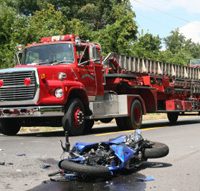The 8 Most Common Causes of Motorcycle Accidents Due to Negligence

Motorcycle accidents share some similar characteristic to other motor vehicle accidents. However, there are distinct differences given the nature of motorcycles, motorcycle riding, and overall injuries that can result. So in this blog we want to share what see as the 8 most common causes of motorcycle accidents due to negligence.
First, What is Negligence?
- Negligence is when either the motorcyclist or the other driver does not “act as a reasonably prudent person,” or behaves in a careless manner causing injury to another person. Consequently, when a driver is not reasonably careful and causes injuries to someone, then that driver is liable for injuring that accident victim.
Negligence and Motorcycle Accidents:
- Negligence is by far the most common cause of motorcycle accidents. In fact, According to the U.S. Department of Transportation’s National Highway Traffic Safety Administration’s Analysis on Motorcycles, speeding accounted for 35 % of all motorcycle riders involved in fatal crashes in 2011 (the latest year data is available).
The 8 Most Common Causes of Motorcycle Accidents Due to Negligence:
Often, as reflected in the corresponding statistics, we see accidents due to negligence resulting from a combination of one or more of the following:
- Speeding
- 35% percent of all fatal motorcycle accidents in 2011
- Driving while under the influence of drugs or alcohol
- 30% of all fatal motorcycle accidents in 2011
- Failing to yield
- i.e., motorcycle was passing, or overtaking another vehicle or continued going straight, rather than yielding
- 24% of all fatal motor cycle accidents in 2011
- Failing to check blind spots before merging
- Not utilizing a turn signal
- Lane splitting
- i.e., when a motorcyclist drives between two lanes
- Ignoring traffic conditions
- i.e., driving too fast in the rain or when visibility is low, or not seeing a motorcyclist due to glare or other view obstructions
- Inexperienced motorists
Going Forward:
There are multiple elements to a negligence claim so it is best to consult with a personal injury attorney who can help walk you through what you will need to prove in order to be made whole.
If you’ve been involved in a motorcycle accident knowing which law applies and what to look for can be the difference between recovering what you deserve and the other driver getting away without any penalty.
Here, at Shiver Hamilton Campbell we have vast experience in the motorcycle accident claims and may be able to work for you. We pride ourselves on taking a more hands on personal approach to our cases by providing our clients with legal counsel and guidance along the way. Speak with one of our attorneys today for a free consultation.
[1] DOT HS 811 765 May 2013 http://www-nrd.nhtsa.dot.gov/Pubs/811765.pdf
[1] DOT HS 811 765 May 2013 http://www-nrd.nhtsa.dot.gov/Pubs/811765.pdf (“In 2011, 35 percent of all motorcycle riders involved in fatal crashes were speeding…”)
[1] DOT HS 811 765 May 2013 http://www-nrd.nhtsa.dot.gov/Pubs/811765.pdf (“In 2011, 1,298 (30%) of all fatally injured motorcycle riders had BAC levels of .08 g/dL or higher. An additional 309 (7 %) had lower alcohol levels (BAC .01 to .07g/dL) (Table 5).”)
[1] DOT HS 811 765 May 2013 http://www-nrd.nhtsa.dot.gov/Pubs/811765.pdf (EDITOR’S NOTE: In 2011, there were 2,449 motorcycles involved in fatal crashes from colliding with another type of motor vehicle in transport, 49% of the total accidents. So there were roughly 4,998 total fatal motorcycle accidents in 2011. Of those 4,998 accidents, 757 were due to motorcycles failing to yield during a turn and 447 crashes were due to the bike going straight. Thus, the total accidents resulting death from failing to yield would be roughly 24% of the whole).


